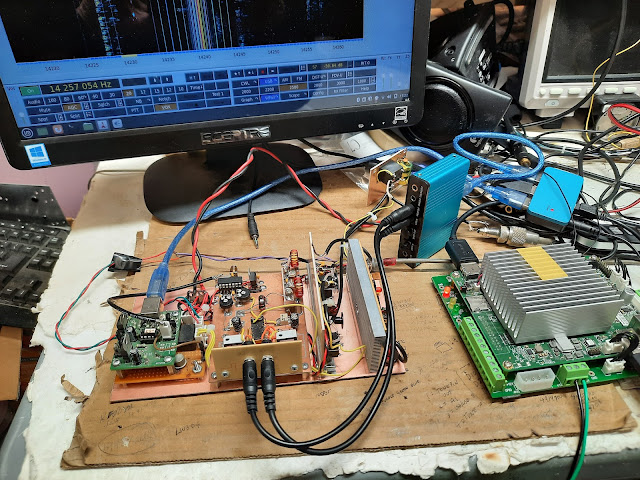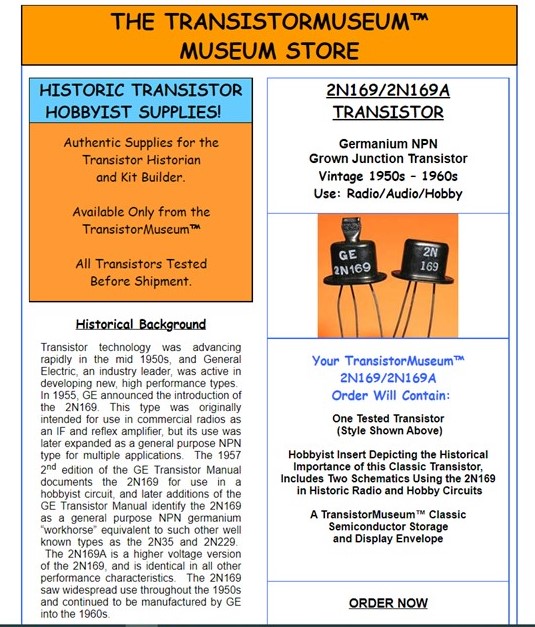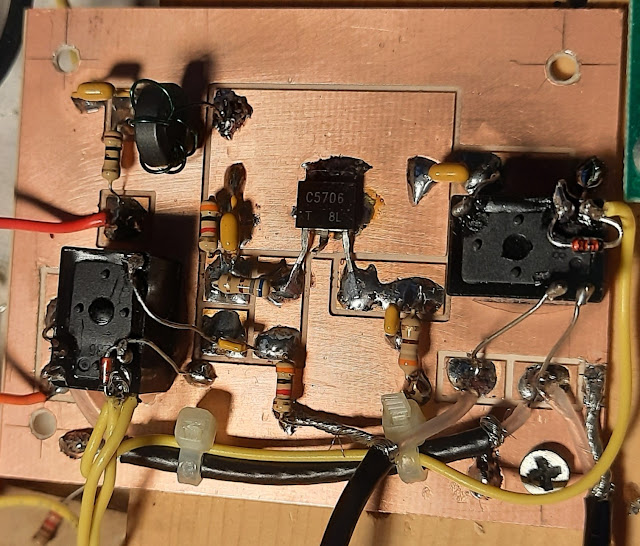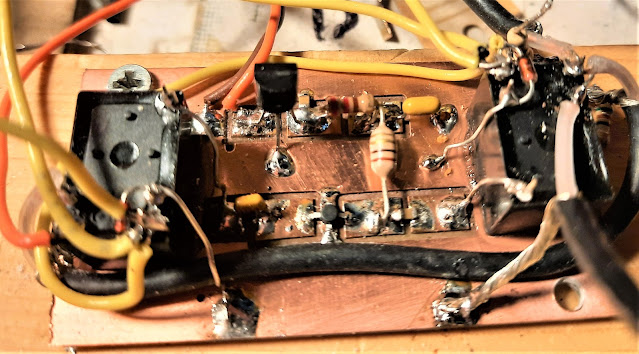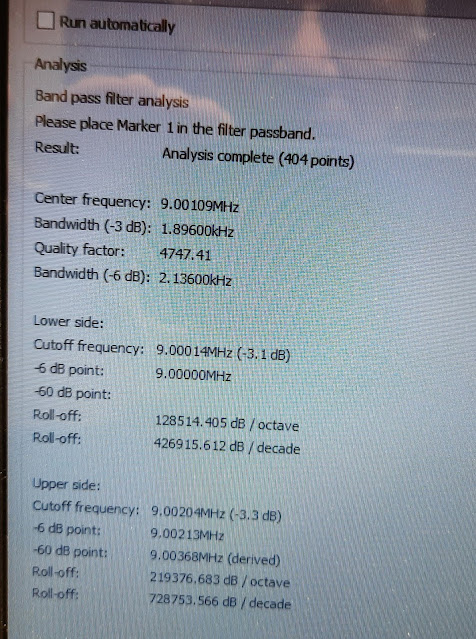2022 ~ The-Peashooter, a 20M Compact SSB Transceiver ~ Updated 2/17/2022. Digital Modes ~ FT-8 & Atomic PI
The Peashooter SSB Transceiver
The SDR Peashooter connected to an Atomic PI SBC
Updated 2/17/2022 ~ FT-8 & Atomic Pi
Like it or not the Digital Modes have taken a place in our hobby. Just as there still are CW enthusiasts, so, are those hams who only operate FT-8 -- even to the point of total automation.
All of my transceiver projects are thought of as experimenter's platforms and the SDR Peashooter is no different. Yesterday was let us play Experimenter's Day, which had two objectives. #1 was to hook up the Atomic Pi Single Board Computer (SBC) and #2 to operate FT-8.
Atomic Pi SBC
I spotted this computer being sold on Amazon as a Developer's Kit including a Baseplate Motherboard, Power Supply and a Camera all for less than $40.
The Bonus it has an Intel Processor and comes loaded with Unbuntu 18.4. It has all sorts of interface ports and two USB Ports. Power options include the supplied 5 VDC Wal Wart but you need an interface cable as well as a 12VDC Port using one of the 4 pin sockets often used with computer power cables.
The 1st Modification from Pete (MFP) was to eliminate the Unbuntu 18.4 and load Linux Mint 20 (64 Bit). If I have to explain how to do that you probably should limp along with Unbuntu. Linux Mint 20 works pretty slick, and the only minor hiccup is when you power down you get the Mint Logo, and you must disconnect the Power to be totally OFF.
QUISK loads nicely as does WSJT-X. I have not tried the built-in Audio Amp which has ports for the Left and Right Channels, and I think it might have a 5-watt amp. It even has some sort of port to connect to an Arduino via the 6-pin header.
There is a downside -- it is big maybe like the size of the ITX form factor. Lacking additional USB ports, I added a small, powered USB Hub and now have five ports instead of two. For home station operation, this is the ticket! With the extra-large heat sink, no need for additional cooling as I found with the Raspberry Pi3 and Pi4.
The other huge downside of the Atomic Pi -- The Developer's Kit @$40 are all gone and so no longer available on Amazon. But Amazon does sell the Atomic Pi SBC and the Mother Board as separate items at $75 (ouch).
FT-8
What is there to say other than it works.
The takeaway, The SDR Peashooter can operate with many SBC's although I would say POX on any Windows install as the loading of QUISK software on a Microshaft Machine is clunky! Sorry Bill, but just like Melinda others have moved on (like to Linux). It also does well on the Digital Modes.
This might be a good point to get back to the hardware Peashooter as parts arrived yesterday needed to finish off the boards and package up the pieces -- 6X4X3 is the goal.
One OBP (Observation by Pete) in the last couple of days the Soldering iron has been cold, and I am really enjoying operating my Homebrew SDR Transceiver. I get no comments about lack of lows or pinched audio, nor you are off frequency by 14 Hz.
My usual track is to avoid mentioning it is a homebrew transceiver, but typically find an email in QRZ.com and will send a short note with a photo. My QRZ.com page now has a photo of the SDR Peashooter. WYKSYCDS!
Updated 2/16/2022 ~ Hard to Find Transistors
So, OK this seems really strange, but I got an email yesterday from Antique Electronic Supply (AES) that they now are stocking some really antique transistors.
See this LINK . Firstly, they have the 2N2222A in the TO-18 case for less than $1, That is a bargain! BUT wait you can actually buy the 2N169 Top Hat Germanium NPN transistor from a reputable supplier. These jewels have a Ft of 9 MHz and might do well in an IF module at 4.9152 MHz.
They also have a bunch of other Germanium transistors that will ring some bells for those who built the 101 Solid State Projects from Tom Knetiel and the likes of Rufus P Turner, Forrest Mimms, maybe even Ed Knoll. (Now we have Wes, Farhan and Hans to create the 101 projects.)
AES has a side hustle of selling guitar parts and many of the old FUZZ boxes had the Germanium transistors, so I see the connection with AES.
Who will be the 1st to translate parts of the PSSST project to Germanium transistors from the old days?
I think one of the SBE Transceivers (SBE-34) used 2N1305 transistors for circuit switching. That is in the listing from AES.
You Have to Think Out of the Circuit Board!
Update 2/14/2022 ~ SDR Peashooter
An SDR Version of the Peashooter. Look Close as this is a complete station including a 7" HDMI Display. WYKSYCDS!
Updated 2/13/2022 ~ More Hardware Decisions
The 2/3 through the project conundrum. The build is going well and that is when you realize you are a lot more knowledgeable today than when you started out. Yes, things are on track, but it is the value of seeing if you had done some things a bit differently initially, then the project could have greater functionality. So, what to do.
Because I build things in modules making changes is a lot easier than dumping a whole large scale circuit board. Typically, my usual approach is finish what was started as the baseline and for a good reason. Downstream likely there are even more changes that could make things better, so it is best to create a "punch list" of these items. So, that is the reason.
Once you have the list then you can evaluate each item separately and then collectively as to impact. Some changes contribute very little to the overall project but would require extensive rework. These are not implemented! The listing also establishes a priority and benefit impact assessment. What gives the most bang for the smallest buck!
It also lets you finish a project without having your work in a constant change cycle and never finished.
Below is a great example. This is a steerable amplifier prototype using the 2SC5706. It works well and was used on the PSSST. But its' form factor could be both a + or -. The tab is the Collector, and it is not easy to fit a heatsink to this device. But you can solder directly to a large copper pad. (OK it is kind of cool how I made a slick circuit board for it.). The downside -- it uses a lot of real estate. Does it work well, of course! Could it be compact -- that is harder to accomplish?
There is a huge bone being thrown out and often this is lost when you buy a kit and just stuff parts onto a board. Building a kit forces you to place Tab A into slot B and you never question could this be better.
Whereas going through the homebrew process unless you are dead from the neck up, you are always asking the why and what if and how to make improvements.
This board later evolved into a MMIC amplifier approach which now has found a home in the Peashooter.
Basically, the homebrew approach is an iterative process subject to continuous improvement that results from design decisions.
Updated 2/12/2022 ~ Back to the Peashooter!
Documenting projects like the Peashooter is a two-way street albeit sometimes "bumpy". Often (not often, but always) I start out with UWIH. (Use What I Have!) The Peashooter has started out with a 0.96 Inch Black and White OLED display.
This display was chosen because I had it and because it is small in keeping with the compact nature of the final product. I have an even smaller 1/2 OLED but no mounting holes. So, this was a compromise based on mounting capability.
Then I get an email literally ripping me a new one, that OLEDs were BAD and Noisy and that was not a good decision. My response -- watch the you tube video as there were no noise issues. There are ways to address the Noise but were not required.
But I was also alerted to a Color TFT display that was the same size as the OLED, had the Mounting Holes and Cheap.
Now this device uses the ST7735 Library, so this is a common library and thusly we can do a lot more. But the caution is that it only an 80X160 --so a bit of a readjustment of what goes where.
The best part they can be found on eBay and the price with shipping was $5 each. I have some on a slow boat from China. This now means some possibilities for color graphics to Mirror the new code for the PSSST.
The display below uses the ST7735 Library but is a 128X160 so some decisions on what to display. But this is more "colorful" than Black and White.
In another email about the Peashooter, I was "roasted" as to why I shifted from the 2N2222A's to the MMIC amplifiers. Well in short here are the reasons so you all know. But this is a designer's choice -- you don't like MMIC's then stick with the 2N2222A's
- The MMIC's are inherently termination insensitive with 50 Ohms Input and Output.
- They are good to the 3 GHz range.
- They offer 20.5 dB gain at 900 MHz.
- They require less parts.
- They can operate at low voltages like 5 and 6 VDC.
- The circuit real estate use offers a smaller footprint.
- I have used them before in my Transceiver Projects and were published --12 years ago!
Fellow hams it is OK to ask why I have made certain design choices and most often it is like when I cook. I go to refrigerator and spy what I have and then a dinner is the end results. I don't shop everyday just based on some preset menu. So, I use what I have and then look for changes the next time I cook!
It is OK to inquire BUT you should by now realize -- there are usually really good solid design reasons for where I start. UWIH!
Updated 2/11/2022 ~ Puzzle Answer Tracks
A dear friend in ZL land pointed out that I should not discount the two tin cans so quickly. His suggestion leads to Mike Rainey AA1TJ who built a voice powered radio transmitter that was heard thousands of miles away.
Now just suppose you "tuned" those tin cans to make them cavity resonators (that would set the frequency) and if you used a sanding disk (wear a face mask) to thin out the bottom of the can with an added pin hole you could make the can bottom vibrate at audio frequencies. But, somewhere in the mix you would need an RF source and Microwave diode (Something better than a 1N67) to act as a mixer to impress the audio onto the RF.
That part (and a lot more) would need to be in place to make it work. But ditch the string, keep the cans, and think Microwaves.
If in the mix of parts, we took a voice coil and magnet from a defunct speaker the voice power could be converted to electrical power to run a MMIC used as a 100th Harmonic Oscillator as our RF source. Hey now some of the pieces are starting to take shape. That covers a way to the Tx part. So now the Rx part would have to be some sort of DCR, and we would need an audio add stage like a 2N2222A and LM-380N-8
Perhaps at the end of the can we have a spiral wound helix antenna, and the can bottom is a reflector to add a bit of gain. So, OK you Microwave guys --tell me I should stop drinking!
Another suggestion was to read the collective works of Rick Campbell KK7B and his R2 T2 project that use phasing techniques to put out a signal. Now we all know that is a well-documented project and there even may be some boards floating around.
Another suggestion in keeping with the PA (Polarized America), screw the regulations and just keep using the crystal filters. C'mon guys this was an exercise to get you to think out of the circuit board.
Likely there are some other solutions including SDR. But the two tin cans mounted on a tripod suddenly has great appeal and is far and away from a circuit board!
Ok next time back to the Peashooter and perhaps by then my 154 Ohm 1% resistor will have arrived.
Updated 2/10/2022 ~ Thank You to those who responded to my call for help. Plus, a Puzzle Question?
Firstly, once again the collegial spirit of hams worldwide has shown itself like a huge beacon. I had several offers of assistance in finding the 154 Ohm 1% resistor that I need for the MAR-6+ MMIC install.
One response was from ZL land, another from the UK and I even had one offer where two resistors were measured on a piece of high technology laboratory equipment to produce exactly the right value and one unit of the exact part that is in route to me. To all of you a huge Thank You! Indeed the "ham spirit rules!"
Now a puzzle question. If crystal filters were outlawed, how would you build a modern rig?
Think before you answer --it may not be that obvious?
To the ham that sent me the email about two Tin Cans and a piece of string -- that is thinking out of the Circuit Board -- But not the answer to the puzzle!
73's
Pete N6QW
Updated 2/9/2022 ~ Parts Shortages Plus a Video of a Homebrew 4.9152 MHz Crystal Filter!
I have started to build a couple different varieties of the Peashooter including one with the MAR-6+ MMIC. That MMIC with a 6 Volt DC Supply needs a 154 Ohm 1% SMD dropping resistor. I placed an order with Mouser on February 1 and today got an email -- the ship date is May 9th of 2022. I cancelled the order and will look elsewhere. BUT I asked is this just a singular part event -- the answer is NO, in that many parts are in this same boat (literally). Shame on us for outsourcing those parts to China. Dumb move!
But the real Biggie is that I ordered a Raspberry Pi4 from Element 14 in June of 2021 at an unheard-of price of $35. I was recently advised that they now had to charge $45, and the delivery was in early 2023. The processor is the issue!
So, if anyone has a 154 Ohm 1% resistor through hole or SMD contact me at my QRZ email address, and we can play "Let's Make a Deal". So, if you would like to see a MAR-6+ in a radio the critical path is one resistor.
Updated 2/8/2022 ~A 4 Pole Installed in a Radio!
The Homebrew 9 MHz filter has been temporarily hay-wired into a radio. This shows great promise for use in a Peashooter variant.
The Dishal component values made this sound terrible, so they were removed! -- Nothing like experience to make things work and that paid off with this filter!
First a lesson learned. My 1st child (son Peter) was born on this day some 53 years ago. The lesson: never wear your favorite V neck sweater to the hospital while your wife is giving birth. During the labor event my wife was having these huge contractions whereupon she grabbed the front of my sweater and while swearing at me, pulled so hard that she permanently distended the sweater fibers so that the sweater now had a bulge in the front shaped like a fist. It was ruined. Happy Birthday Peter!
Now here is a plot using VNA Saver of the same filter shown yesterday on the Nano VNA. Somehow the photo yesterday make it look flatter on the band pass. But the use of the VNA Saver is to give you the BFO frequencies with more accuracy.
Updated 2/7/2022 ~ A 9 MHz HB Xtal Filter
Without having some specific deadline to meet I have been making forays into possible alternative modules that can be used in the Peashooter. Today it was 9 MHz Crystal Filter Day.
Actually, I had built this Filter long ago following one of the prescribed methods (like Dishal Dystopia or the AADE program) but soon realized that the initial build was not very good. So today I ripped out the Capacitor values derived from those programs and simply soldered in five 47PF size 1206 SMD caps.
Next, I started with a 4:1 matching transformer and made runs with my Nano VNA. I ended up with 12 Turns total tapped at the 4th Turn. Using what you learned from the earlier posting 12^2 = 144 and 4^2 = 16 so that 144/16 = 9:1. So our 50 Ohms is now 450 Ohms at the filter. I should buy some lottery tickets.
Updated 2/6/2022 ~ The Wrong Stuff!
A popular movie many years ago about the Space Program, I think, was entitled "The Right Stuff". This of course conjured up a view of super powerful superheroes flying through space, but I thought that it was more of ordinary individuals doing the right things at the right times.
In the Fall of 2021, I participated in the G-QRP Second Virtual Convention covering the subject of Valve CW Transmitters. (That really is a case of Brown Shoes with a Formal Black Tuxedo.) I really didn't think it was too good of a presentation as there was very little feedback from those who watched. I just sort of put it out of my mind but must confess I learned a few things while preparing the information.
The two key pieces of info garnered during the research were that 1) Jean Shepherd (Mentor to N2CQR, a ham and famous Talk Show Host on NY Radio) had as his favorite Transmitter the TriTet Oscillator and 2) That using a special series of Ferrite cores you can homebrew 2.5 Millihenry Chokes using a small number of turns.
Then Boom, yesterday I got an email from a ham who built the 6V6 Oscillator that was featured in my presentation, but he was only getting 1/2-milliwatt output with only 200 Volts on the Plate. His quick conclusion was too low of a plate voltage.
Well certainly too low of a plate voltage will result in low output BUT certainly more than 1/2-milliwatt. The purpose of his email was to ask what 9 pin miniature tubes might be used to scratch build a different transmitter so he could get more power output. That is the Wrong Stuff!
My response tried to outline what do you know and what is the path to get you to the right answer. His 1st approach builds a different rig.
But that brings up an issue with the Peashooter. I noted after working really FB suddenly the audio output went really low. So where do you start? The fact that it was receiving at all was critical and that it worked as before on transmit was another factor. That was Key!
OK on transmit made the case that any common circuit, and any single pass circuit along with the transmit only stages were working properly. That left only one stage --the audio amp itself.
To make things compact I had used some SMD coupling caps in the audio amp and for some reason the input coupling cap following the ADE-1 when operating as the Product Detector was bad. A quick replacement of that cap and back as usual. I did not start by a wholesale rebuilding of the audio amplifier.
Another case that leaves you head scratching. A friend has built a DCR receiver and found that the RF amp stage had too much gain on 40M but not enough gain on 20M. I suggested the use of a variable gain amp stage using a pair of J310 configured as a Dual Gate MOSFET. I have used this stage in several of my projects. He built that stage, but it didn't work as per the LT Spice simulation nor in hardware.
He then began looking at the build and came upon a 2.2K Ohm resistor which when measured was 22 Ohms. No, he did not put the wrong value in the build -- he had a pack of 10 resistors that were banded for 2.2K but all measured 22 Ohms. It was a factory screw up. So probably a good idea to spot check the values you install as they may be "The Wrong Stuff!"
Having a measured and formal troubleshooting process is key to successfully building the Peashooter.
Updated 2/5/2022 ~ Stuff for Those who Abhor the Si5351. For use with a homebrew Crystal Filter. A Super VXO and BFO
I would use a 4.9152 MHz Filter along with a 19.2 MHz Super VXO to give about a 32 kHz swing on 20M. The devices are SMD - 2N2222A's. The BFO is the test oscillator used for characterizing crystals.
Updated 2/4/2022 ~ Topology Blueprint
1. Operation on 20M SSB (USB/LSB)
2. A 9 MHz IF with a 23MHz LO
3. Arduino Pro-Mini + Si5351
4. Steered Modules (ala PSSST)
5. Use of Three (03) MMIC Amplifiers
6. Use of 2N2222A SMD in two circuits (Audio & Mic Amp)
7. The RF Chain: 2N2219A and IRF510 for Transmit
8. The Goal: 5-Watt Power output
9. Include Battery Powered Operation
10. A Box: 72 Cubic Inches in size
11. The Use of a Miniature OLED Display.
Note I discovered by reading the "detail" on this OLED you can invert the print. The 1st photo above shows the white background with black lettering which can be Inverted to a black background with white lettering as can be seen in the 2nd photo.
The diagonal line can't be seen by the naked eye as it is the raster scan, but the phone cameras sure can pick it up. I have to do some testing to perform as to which scheme is better in bright sunlight and/or low light levels.
Afterall the Peashooter is intended to be used for SOTA and POTA as well as CMAT (Chick Magnet Attraction Tool).
Pete N6QW
Updated 2/3/2022 ~ READ!
Start by navigating to the N6QW website and look at the Link on "How to build a SSB Transceiver" and then the Link to the PSSST project. The Peashooter builds on those two documents. READ and understand both of these links! You cannot successfully build the Peashooter without doing the homework!
I have in hand several questions about the PSSST and the Peashooter projects where it is obvious the person asking the questions did so without doing the homework. Both projects use a Single Pass IF Module and the IF Module is NOT BITX Bilateral! Grrrr -- that was the whole concept --no BITX stuff!
A family member has been in Hospital now heading toward a month; but is now in a rehab facility (not drug related) and should finish the tour in in about three weeks. At Hospital no visitors but now in Rehab you can visit; but must have in hand negative Covid19 tests (both forms).
I had my very 1st Covid19 test on Monday and is best described as a two-foot-long nasal swab that when inserted reaches the "Pucker Point". I hit the Gag button.
To law enforcement -- this may be a new tool for perpetrator questioning. I will have to do this unseemly act every three days for the next several weeks -- that comes to about 7 more tests.
2/2/2022
The Peashooter was a favorite toy of youngsters of old. Essentially you took a bag of dried peas and using a small diameter tube (like 1/4" ID), about 18 inches long, and there you had a primitive "blow gun".
Depending on your lung power you could propel the peas tens of feet and doing so with extreme accuracy. While a toy, it still had the power to shoot your eye out. Somehow, we just know Jean Shepherd (Mentor to N2CQR, famous ham and talk show host) had one of these. He also was the impetus for the "shoot your eye out" movie, A Christmas Story, based on his publication of "In God We Trust, All Others Bring Cash! "
So, the connection with a Peashooter and the N6QW Homebrew SSB transceiver design is actually almost a perfect match to the concept of a small, simple device, that is stealthy, powerful, accurate, a delight to operate, low in cost, BUT with a difference in that it is not a TOY!
Peashooter Block Diagram
The 2N2222A's in the steerable sections are now MMIC's
(Note the MAR-6+ MMIC is a drop in substitute with a Bias Resistor Change.)
The Peashooter will apply all of the information supplied in the prior lengthy blog posting on Building an SSB transceiver. You now will see an application of all of the "good stuff".
This project objective is to build a small sized SSB Transceiver that can be carried into the field, up a mountain top (SOTA) or to Parks on the Air site (POTA).
So, OK the Peashooter is not everyone's cup of tea -- but it is my blog. Stick around as you might pick up a nugget or two.
Start by thinking of an enclosure that is 6 X 4 X 3.
73's
Pete, N6QW
